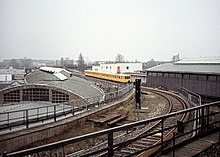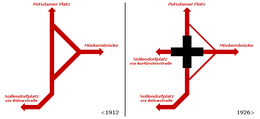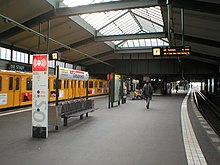Gleisdreieck underground station
The Gleisdreieck underground station is an above-ground underground station in the Berlin district of Kreuzberg in the Friedrichshain-Kreuzberg district , where the U1 / U3 and U2 lines intersect on two levels.
investment

The Gleisdreieck underground station is a tower station . The lower platform of the U2 line is 103 meters long and ten meters above the street. The upper platform of the U1 and U3 lines is 110 meters long and is partially covered by an 81 meter long hall. It is 15 meters above the street. Both platforms are connected by an elevator, another elevator leads from the platform of the U2 to the street, so that the station is barrier-free .
To the west is the area of the former Potsdam train station , which has now been transformed into a park at Gleisdreieck , and which is crossed by the long-distance railway tunnel.
history

The Dresden train station, built in 1875, used to stand here . It was closed in 1882 and gradually dismantled. The track triangle was then built on the open area.

Today the name Gleisdreieck has nothing to do with the form and function that gave it its name. Until 1912, the branching trains actually ran in a triangle of tracks here . As early as 1907 there were plans to build a crossing station at this point. However, they were not initially implemented.
Accidents: reason for construction
On September 26, 1908, two trains ran in opposite directions - one from Leipziger Platz , the other from Bülowstrasse - towards the Gleisdreieck. Both turned off at the Gleisdreieck at the same time in the direction of Möckernbrücke , with the train coming from Leipziger Platz crossing the signal that was on "Halt" .
There was a flank drive . The first car of the approached train fell from a height of eight meters onto the square below. 16 people died on the same day, 18 others were injured, some seriously, and 2 more people died in the following days. The driver who disobeyed the signal was sentenced to one year and nine months in prison for his confession .
After another - similar, but less serious - accident on May 17, 1911, the track branching was canceled from the summer of 1912 and a new station was planned where the trains would cross one another. The designs came from Sepp Kaiser .
construction
The Gleisdreieck station was built in 1912/1913 in an elevated position between the tracks of the Anhalter , Dresden , Stamm- and Wannseebahn .
The lower platform, which was initially built, is wide so that the temporarily necessary transfer traffic could be handled. The current form as a tower station with two lines in a brace to Nollendorfplatz and the upper platform has existed since the opening of the relief line in 1926, which is now used by the U1 line.
In the divided city

Line A ended at Gleisdreieck after the Wall was built on August 13, 1961 (from 1966: Line 2), for which turning systems were attached in the early 1950s . Since this operation was no longer economical without continuing to the Mitte district , the trains ended on January 1, 1972 at Wittenbergplatz (from 1984: U2). However, line B continued to serve the Gleisdreieck station (from 1966: Line 1, from 1984: U1) and stopped at the upper platform, to which passengers came through the passage of the stationary lower platform.
The SelTrac train control system was tested at Gleisdreieck from 1977 to 1979 . Between 1984 and 1991, the lower platform was a terminus of the monorail M train that the train station perverse Kemper place from here. For this purpose, the western edge of the platform was provided with automatic platform screen doors. After the fall of the Berlin Wall , the M-Bahn was dismantled in favor of restarting the U-Bahn. It took two years to rebuild, so that on November 13, 1993, the U2 subway line could run again continuously from Ruhleben via Gleisdreieck to Vinetastraße .
After reunification
In order to renew the aging station, the Berliner Verkehrsbetriebe began in 2009 with a comprehensive renovation of the tracks, the platforms and the entrances as well as the roof surfaces of the station building. Overall, the costs should amount to around twelve million euros; the renovation should be completed in September 2012. As part of this construction work, the station was given two elevators, so that the station can be used without barriers . The first elevator went into operation on September 30, 2010, the second followed on April 19, 2012.
future
The 200 meter long and listed steel bridge on the U1 level to the west of the train station is to be replaced by a new building from 2020 due to its age. First, in June 2017, scaffolding was installed under the bridge so that it could be inspected more frequently. In addition to the two main tracks, it has a dirt track in the middle. The bridge has been in operation as a sweeping system since 1912, and the mainline tracks went into operation on October 24, 1926.
With the construction of the S21 S-Bahn line, it is planned to switch to the S-Bahn in the future . The S-Bahn station is to be arranged parallel to the platform of the U2.
park
The term Gleisdreieck is now also understood to mean a 60- hectare Berlin project development area on the former freight yards of the Potsdam and Anhalter train stations . The Park am Gleisdreieck was built on parts of the site between 2011 and 2014 .
Movie and TV
- The German FDF feature film Gleisdreieck (1936/1937) is set in the vicinity of the Hochbahnhof .
- The bread of the early years , 1961.
- In the ARD - TV Series practice Bülowbogen there was a homeless man was the "Gleisdreieck" called (played by Klaus Schwarzkopf ). This nickname referred to the homeless person's favorite place to stay, the area of the Berlin Gleisdreieck.
- In the 2001 feature film Emil and the Detectives , a scene takes place on the platform of the underground station. The station can be identified because a sign with the station name is briefly captured by the camera.
- The video clip for Udo Lindenberg's song Sonderzug nach Pankow was shot on the upper platform of the Gleisdreieck underground station.
Connection
The underground station is only served by lines U1 / U3 and U2; There is no direct transfer option to other local public transport lines in Berlin . The next bus stops are in Schöneberger Straße on the Landwehr Canal .
literature
- Axel Mauruszat: 100 years of the Gleisdreieck high station . GVE-Verlag, Berlin 2012, ISBN 978-3-89218-333-4 .
Web links
- Entry in the state monument list
- BVG map of the station (PDF; 84 kB)
- The Gleisdreieck on berliner-verkehrsseiten.de
- Description of the train stations on the relief line, including the Gleisdreieck underground station
- Information sheet on the Gleisdreieck elevated railway station (PDF) from the Berlin Center for Industrial Culture
Remarks
- ^ Ludwig Ritter von Stockert : Railway accidents. A contribution to railway operations theory. , Volume 1. Leipzig 1913, p. 196, No. 74, names 17 dead and 18 injured.
Individual evidence
- ↑ Another photo: Ludwig Ritter von Stockert : Railway accidents. A contribution to railway operations theory. , Volume 2. Leipzig 1913, Fig. 48.
- ↑ Digitized edition of the Rhön-Zeitung (Vacha) from September 28, 1908 (please page forward to → 1015 )
- ^ A b Hans Joachim Ritzau: Railway disasters in Germany. Splinters of German history . Volume 1: Landsberg-Pürgen 1979, p. 99.
- ↑ Heinz Gläser: Dangerous Gleisdreieck - The elevated railway accident of September 26, 1908 . In: Berlin monthly magazine ( Luisenstädtischer Bildungsverein ) . Issue 9, 1999, ISSN 0944-5560 , p. 98-101 ( luise-berlin.de ).
- ^ Brian Hardy: The Berlin U-Bahn . Capital Transport, Harrow Weald 1996, ISBN 1-85414-184-8 , pp. 24 .
- ↑ Renovation work on the Gleisdreieck underground station (U1) and the adjacent viaducts . Press release of the Berliner Verkehrsbetriebe, July 16, 2010
- ↑ From tomorrow the U1 will run again between U Möckernbrücke and U Wittenbergplatz . Press release of the Berliner Verkehrsbetriebe, June 7, 2012
- ↑ Interim balance sheet, BVG summer construction sites . Press release of the Berliner Verkehrsbetriebe, July 28, 2010
- ↑ Current priorities of the elevator program of the Berlin Senate 2011-2016 (PDF, 89 kB), Senate Department for Urban Development, June 9, 2009
- ↑ News in brief - U-Bahn . In: Berliner Verkehrsblätter . No. 7 , 2017, p. 134 .
- ^ Gleisdreieck (1936/1937). ( Memento from September 30, 2007 in the Internet Archive ) deutscher-tonfilm.de
- ^ Go East - Western stars in the GDR . Documentary series ZDF-History ; broadcast by ZDFinfo on May 30, 2014.
Coordinates: 52 ° 29 ′ 58 ″ N , 13 ° 22 ′ 27 ″ E





